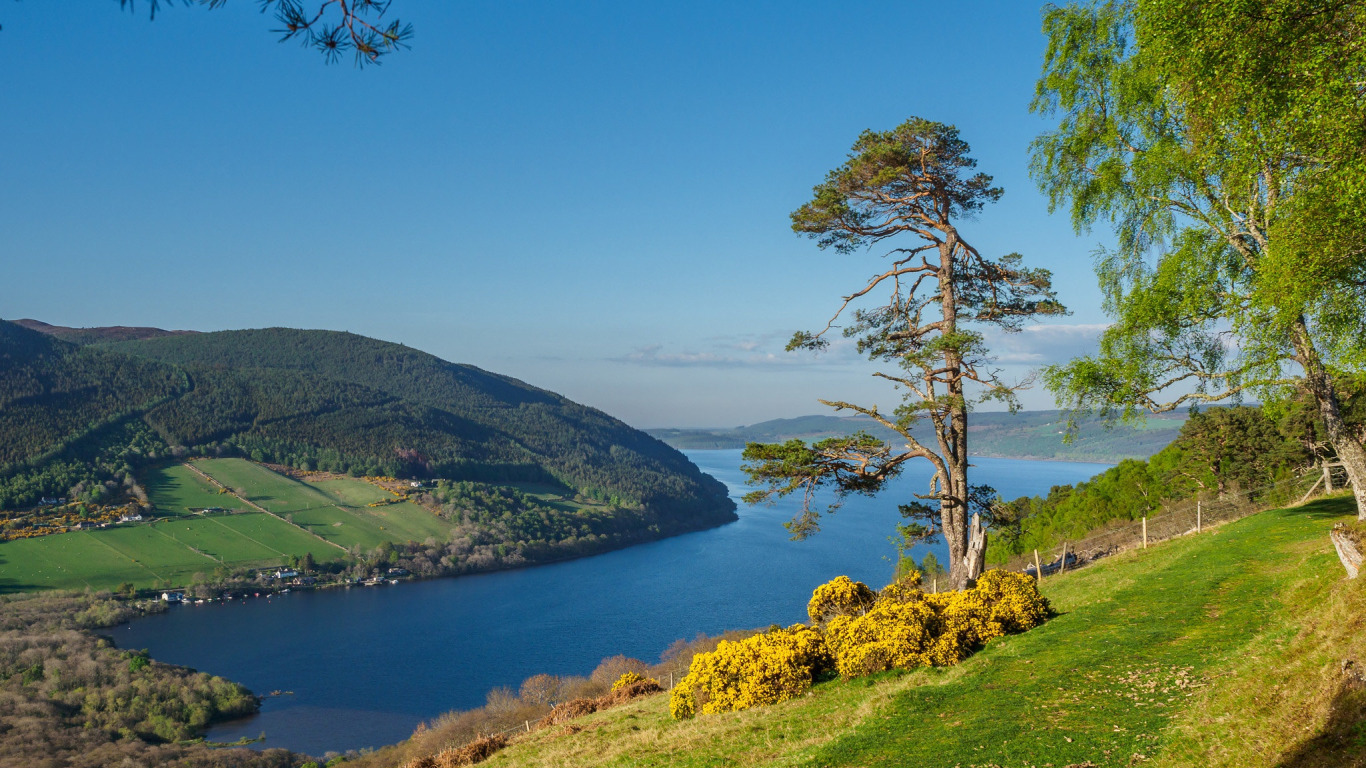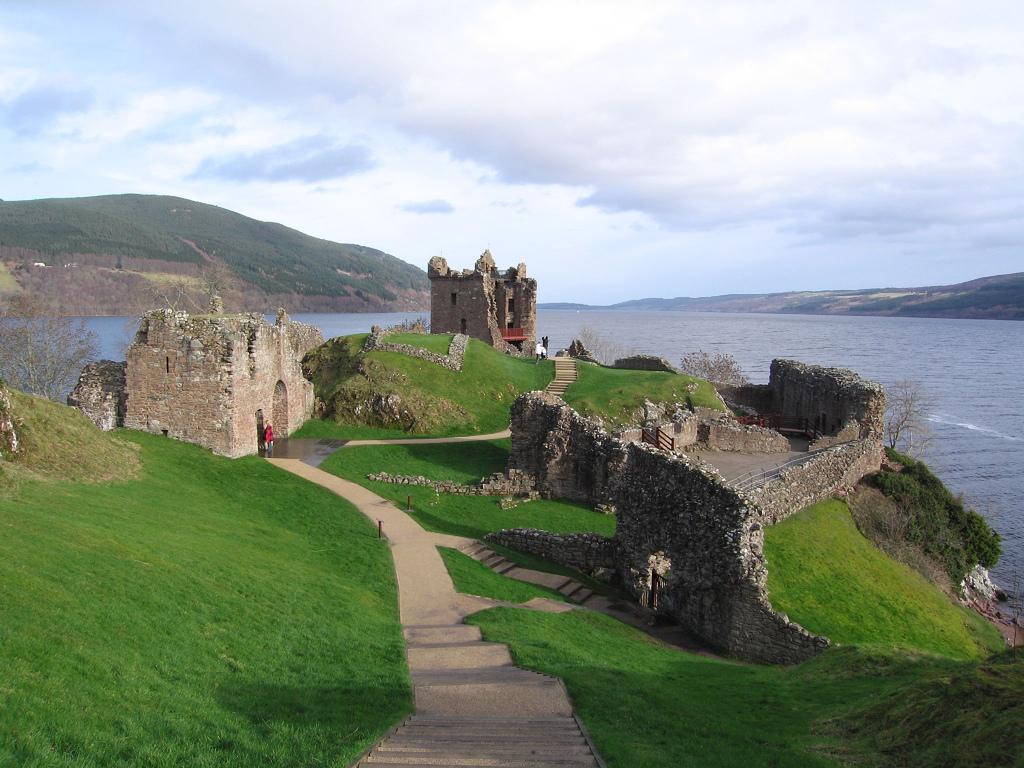The Loch Ness Monster is a quintessential piece of Scottish folklore. More than that, it’s an international sensation that took the world by storm, and this monster tale still captivates audiences worldwide.
It’s probably the most well-known mythical or realistic (depending on who you ask) creature in the world. Let’s brush up on our Loch Ness Monster facts and dive right into the mysteries!
The Loch Ness Loch

This loch is located in the Scottish Highlands and contains the largest volume of fresh water in Great Britain — more water than all the English and Welsh lochs combined! Loch Ness lies in Great Glen, where it bisects the highlands and connects to a system of waterways across Scotland, which is connected by the Caledonian Canal.
The River Ness is the loch’s outlet flowing into the Moray Firth at Inverness. Situated at the head of the loch is the monastery of Fort Augustus. The Loch Ness shores also host the majestic remains of the Urquhart castle.
So, how deep is Loch Ness? It reaches depths around 240 metres (almost 800 ft), and it is about 36 km in length. The loch’s shores are said to be even deeper than the North Sea.
Have these interesting Loch Ness facts left you wondering how this enormous body of water appeared? Let’s examine one captivating explanation below.
The Mythical Origins of the Loch
There’s actually super interesting lore surrounding the formation of this majestic loch. This is probably why it makes for a brilliant monster playground. The Loch Ness story springs to life from the Cailleach Bheur. The Hag goddess is well known for affecting the Irish landscape, and this tale is no different.
According to legend, the Winter Goddess had a maid called Nessa. One day, Nessa was slacking off, which enraged Cailleach, who turned Nessa into the River Ness. However, River Ness did not want to be contained, so she spilt out to create the deep and mysterious waters of Loch Ness.
And naturally, this mythical body of freshwater is now said to be the home of a strange aquatic creature. Any guesses? Our beloved Nessie, the Loch Ness Monster.
The Legendary Loch Ness Monster
The Loch Ness monster is most commonly described as a large creature with green scales. It’s also known to share features with a sea serpent, although in this case, the Loch Ness Monster would be more of a loch serpent, considering that it lives in a freshwater loch.
This monster is often described as having an extremely long neck and one or more humps protruding above the water’s surface. Accounts of the Loch Ness Monster date back to ancient times. The Pict tribes depicted a beast with flippers in one of their stone carvings.
Numerous sightings and eyewitness accounts make it hard to describe the creature accurately enough, leaving much to the imagination.
Sightings of the Loch Ness Monster
Although there seems to be an array of photographic evidence and imaginative images, questions like “Is Nessie real?” or “Is Nessie fictional?” still circulate today. We can’t draw a factual conclusion, but we can explore some instances of famous Loch Ness Monster sightings.
Earliest Sighting
The earliest written reference to Nessie comes from 565 AD in a report by an Irish Monk, Saint Columba. He was residing near the loch and encountered a man burying a body. A water beast allegedly killed a man. The Saint then sent his companion to verify the story, and the monster retaliated. Saint Columbus apparently forced the creature back into the water, and it retreated into the loch’s depths.
1933
Hugh Gray was taking a lovely post-church stroll with his doggo in clear weather. He spotted something in the water, snapped an extremely blurry picture and contributed to the world’s most famous monster hunt. Most people believe it to be a picture of his dog getting a stick from the Loch’s water.
This blurry image seemed to be accepted as conclusive evidence of the monster’s existence as months prior; local residents mentioned to the Inverness Courier that they had witnessed “an enormous animal rolling and plunging on the surface”. The sighting and the photograph combined sparked an international media phenomenon.
The “Surgeon’s Photograph” (1934)

Another famous Loch Ness Monster sighting is the iconic 1934 photo of the “surgeon’s photograph.” The image, taken by London gynaecologist Robert Kenneth Wilson, depicts the small head and long neck of this large animal. This well-known photograph was proven to be a hoax.
In 1994, it was discovered that the image had been a plan to dupe the Daily Mail, which originally posted the image. It was discovered to be a heavily cropped image of an upside-down toy submarine. But between us, that looks awfully a lot like a submerged elephant swimming with its trunk out.
Most evidence supporting the monster’s existence has been discredited, and the creature that the sightings describe remains a myth.
The Science Behind the Loch Ness Mystery
Scientists have been trying to figure out this juicy mystery for a long time and attempting to answer the looming question on everyone’s mind: “Is the Loch Ness Monster real?”. Well, many sightings have been proven false. However, the sheer number of sightings extends to over 1000 Loch Ness sightings.
Many in the scientific community laugh off the existence of this strange aquatic creature. They explain the claimed sightings as a hoax or attribute them to a simple misidentification of everyday objects like an upturned boat.
In 1960, Oxford and Cambridge University researchers founded an expedition, or Loch Ness Monster search, to investigate the increased sightings and gather some facts about the Loch Ness Monster. The sightings of Nessie were attributed to boat husks due to the increased boat traffic on the loch.
In 1962, research observing the loch’s surface and the change in water temperatures concluded that the loch was prone to creating mirages. In calm weather conditions, the mirages can make ordinary Loch Ness creatures look like Loch Ness monsters. So, it’s safe to assume that many Nessie sightings were mere mirages.
In 1975, photographic evidence captured with underwater photography seemed to convince the public that a prehistoric monster was alive and well. This Loch Ness Monster photo looks similar to an animal believed to be long-extinct Plesiosaurs.
The scientists on the 1981 Loch Ness project conducted numerous studies in the waters to determine the validity of the claims that this large beast actually exists below the surface. Various researchers conducted sonar studies, which showed that there were, in fact, unknown large animals in the depths of the famous loch.
In 2018, several universities collaborated on a large-scale DNA survey. They collected DNA samples from the loch’s environment to determine every living organism within its depths. Although their results did not show any evidence of any prehistoric monster or other such large animal, there were overwhelming samples of eel DNA. Could the beast simply be an oversized eel?
The Truth Behind the Loch Ness Sea Monster
To answer the question, “What is the Loch Ness Monster?” Some possible explanations for Nessie’s sightings are that it could be a swimming deer, an unusually large Wels catfish, wind slicks, other large fish species, or optical illusions conjured up by floating logs and other objects. A more folklorish explanation would be that it’s a large relative of the Scottish water horses called kelpies.
Places to Try to See the Loch Ness Monster
Is the Loch Ness Monster real? The best way to answer this is to experience a Loch Ness sighting first-hand, right? Merely going off a grainy Loch Ness Monster picture won’t be half as satisfying as visiting the following places and trying to spot this mystical creature yourself.
1. Urquhart Castle

This Loch Ness castle, overlooking Urquhart Bay, offers panoramic views of the loch, so you can try to spot Nessie from 360 degrees of perfect open water scenery. Bring your binoculars, cameras, and notepads and kick-start your investigation.
2. Loch Ness Boat Trips

There are several Loch Ness cruise trips available with informative guides spilling fun facts about the Loch Ness Monster and retelling Loch Ness monster stories while you keep an eye out for the beast.
3. Water Adventures
Get up close and personal with the Loch Ness Monster of Scotland via kayak or paddle boat adventures. While we know Nessie stays within the depths of the loch, the creature might just stick her head above the water to say hello — who knows?
4. Loch Ness 360 Trail
There is a scenic circular trail around the Loch Ness in Scotland along Great Glen Way. The trail is about 80 miles long and allows visitors to experience the stunning Scottish views and perhaps gain evidence of the existence of Nessie the Loch Ness Monster.
5. The Loch Ness Centre

The Loch Ness visitor’s centre offers a comprehensive look into the legendary Loch Ness Monster at the site of the famous, now newly renovated, Loch Ness Inn. This hotel was the epicentre of one of the biggest Nessie hunt phases back in the day. They offer a one-hour Loch Ness Monster tour where visitors can explore objects, artefacts and secrets surrounding the renowned creature.
FAQs About The Loch Ness Monster
We’ve dived into the depths of the lore and scientific studies surrounding the Loch Ness creature, but we’ve hardly gathered enough evidence to answer some important questions.
Now, let’s take a look and recap the questions we’ve discussed for the perfect snapshot.
What is a Loch Ness Monster?
The Loch Ness Monster is a mythical creature residing in the immense depths of the Loch Ness waters (well, maybe).
What does the Loch Ness Monster look like?
Eyewitness accounts provide varying descriptions, but the most common attributes for Nessie include:
- A humped back
- An elongated neck
- Reptilian features
How to find the Loch Ness Monster?
For a Nessie sighting experience, arrange a trip to this famed freshwater loch, which it calls home. The loch is 37 kilometres southwest of Inverness.
Does the Loch Ness Monster really exist?
This is a loaded question. No scientific evidence has proven the existence of a Loch Ness Monster in the Inverness region. However, the Loch Ness Monster does exist in the minds and imaginations of all those who believe in it, and maybe that’s good enough.


